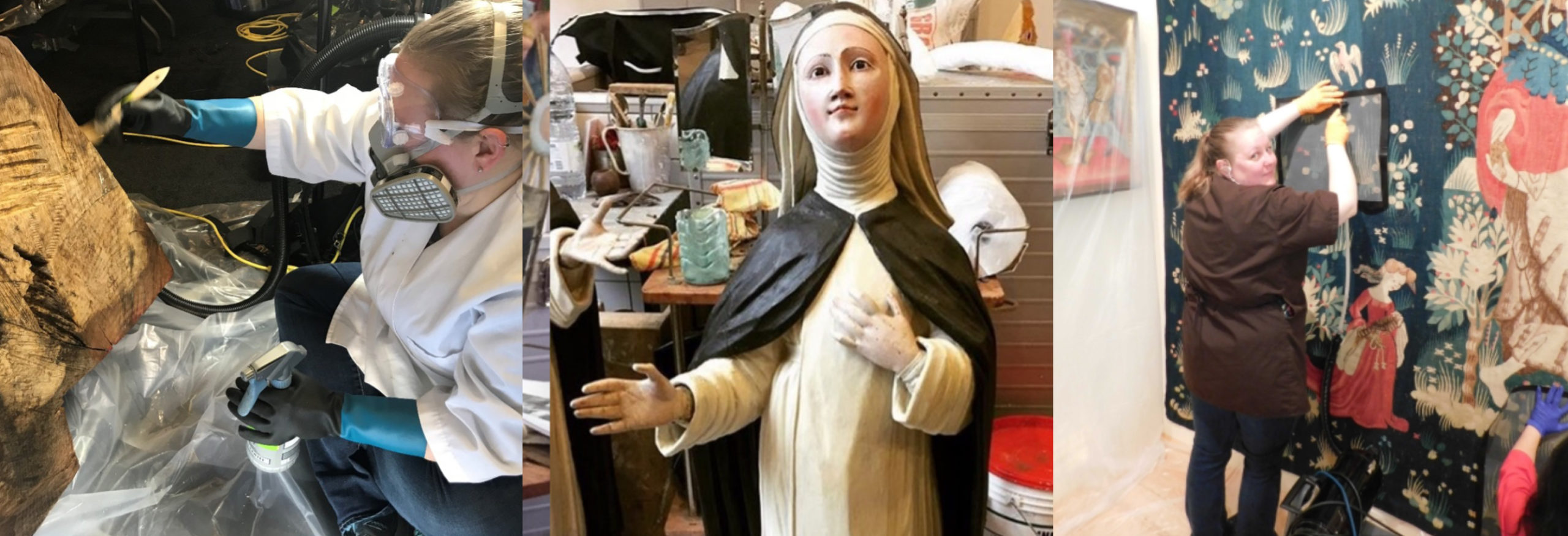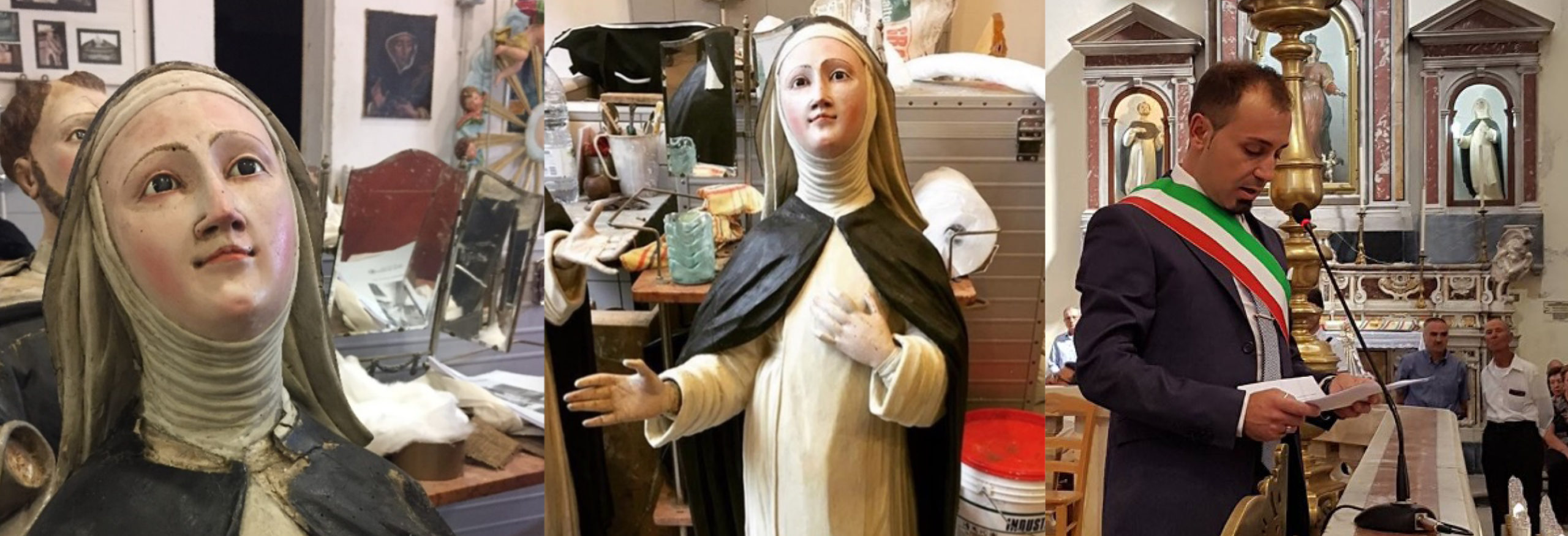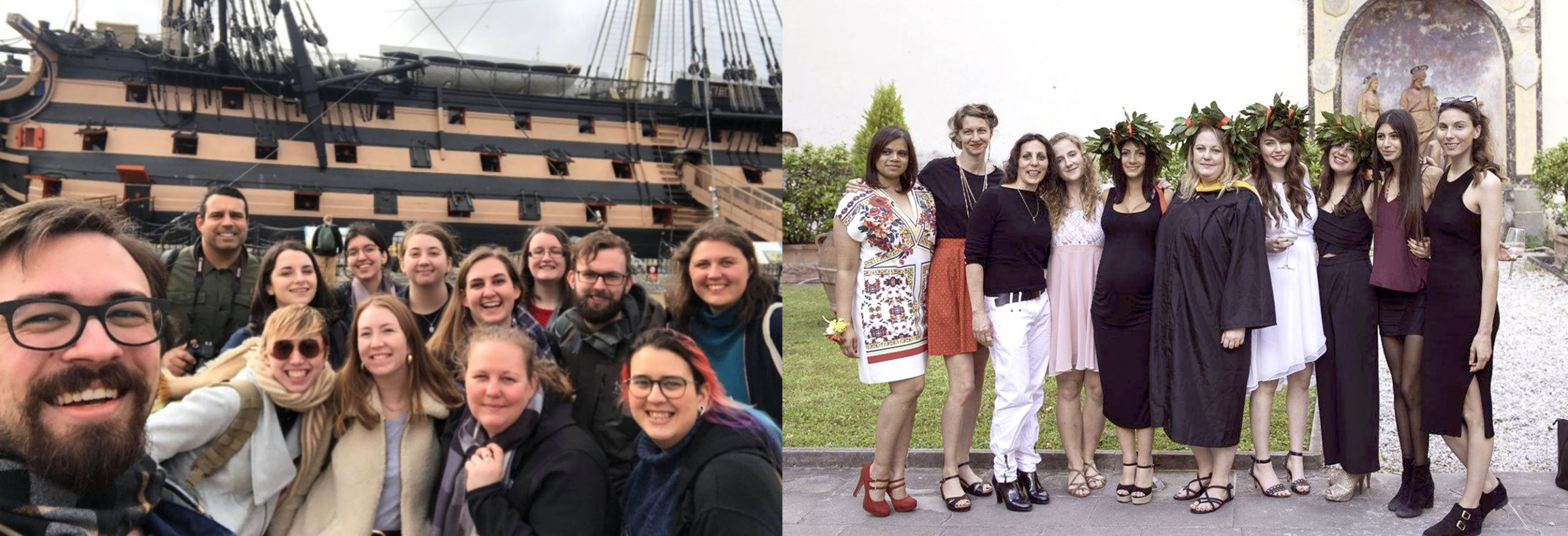
Conservator at the Warren Lasch Conservation Center of Clemson University, South Carolina
Kate Dieringer, Marist-LdM Alumna, shares with us glimpses from her journey across the world to become a professional conservator.
Dear Kate, thank you for taking the time to share your story with us! When and how did your interest in conservation start?
As I was attending Indiana University, pursuing a BA in fine arts, I had an amazing art history professor that became a trusted mentor to me. After many deep conversations about our passions, experiences, travels, and goals, I wasn’t quite sure that fine arts was the direction I should be heading. She briefly mentioned conservation and studying abroad, and honestly, it was never a career I had ever thought about, but I started researching that night and for over a year, as I finished my degree with IU, I started making bigger plans for myself which included moving to a different country and starting over with a new degree!
In retrospective, why do you think that Florence and the Marist-LdM Program were the right start to your career?
When I started my search, I was looking for an American university that offered a program in Italy. Unsure of where I wanted to end up in the long run, I wanted to make sure that I attended an US accredited university so I would not have any issues working within the US. I found Marist-LdM through many hours of online research and I kept coming back to it because I was drawn to the way the program was laid out and obviously the location. I emailed Marist to get some additional insight on how the program worked. I was going into this as a mature student and knowing that one of their main focuses was the Florence Freshman Experience (FFE), I did not want to feel out of place being an older student. But the whole process and experience was better than I could have ever expected. Everyone made me feel so comfortable and I did not feel like I didn’t belong there. The staff at both Marist and LdM were unbelievably supportive. My teachers helped me solidify my interest and passion for conservation. All those I encountered took the time to get to know their students and were there for any additional help needed. Lorenzo Casamenti, my conservation professor, and his assistant Lisa, helped me build my skills and confidence in treatments and Gregory Burney, my painting and drawing professor, helped me finetune the hand skills and techniques needed for precise, detailed work. These three played huge roles in helping me get to where I am now in my career, in every way possible. Probably more than they even know! And after all these years, I know I can still go to them for advice, so I think I got more from Marist and LdM than I had ever anticipated.
Is there a project from your time in Florence that until today retains a special spot in your memory or that you feel has been an important stepping stone in your career?
As a conservator, I become emotionally invested in every object I work on. While in Florence, we worked at multiple onsite locations restoring frescos, which, in itself, is an amazing opportunity. There are not many places where fresco conservation is taught. Aside from that experience, my first completed statue in wood restoration class will always hold a special place in my heart since it was my first completed piece. It was a 16th C. statue of Saint Catherine from a church in Calabria. It came to the studio with a termite infestation, a large amount of wood loss, and weakened areas. Not only did I get to work on a piece which had multiple issues and had to navigate around the how, what, why, and where of it all, but I also got to discuss the differences between conservation and restoration and the ethics behind why something was or wasn’t done.
After its completion, we were sent pictures from those at the church showing it on display, and that gave me a sense of pride knowing I did that, and it was now there for everyone to see.

After your graduation, you moved to San Francisco, California, to work for a private conservation studio, where you work on various projects and different materials, including metals, wood, paintings, latex, and textile. Can you tell us more about this experience?
I started applying for internships before graduation to help prepare myself for the transition between then and grad school. I knew I wanted to continue with my master’s degree but was unsure where I wanted to go and, with most schools in the US requiring internship hours, I wanted to start right away. It was not easy. It is important to start building relationships, either online or in person, with different groups like AIC, ICON, on LinkedIn, or even in different groups on Facebook. I was lucky enough to meet someone in Florence who was able to connect me with an acquaintance of hers who owns her own business, and that was where I interned.
Working in the private sector of the conservation field was nothing that I could have imagined, in a good way . I learned so much while working there. Not only was I exposed to different object materials, and was able to determine where I wanted to focus my concentration for grad school, but also received experience writing treatment proposals, ordering supplies, and emergency treatment plans. I got to learn new processes, modern techniques, and interact more with clients.
 Your journey continued, and, after San Francisco, you moved to Cardiff, UK, where you started your graduate program in Objects Conservation. Your very first project there consisted in cleaning and packaging a selection of mummy bandages from Egypt. We couldn’t imagine a more exciting start! What has been your favorite project during your time in Cardiff?
Your journey continued, and, after San Francisco, you moved to Cardiff, UK, where you started your graduate program in Objects Conservation. Your very first project there consisted in cleaning and packaging a selection of mummy bandages from Egypt. We couldn’t imagine a more exciting start! What has been your favorite project during your time in Cardiff?
My favorite object I got to work on was a cellulose nitrate and copper alloy hair ornament from Bristol Museum. I had never worked on any modern materials before this, and I requested the object because I knew it would be a good skill to have as I transitioned into a career, and I wanted a challenge. It was a part of a large collection that was donated to the museum by a prominent English art and jewelry collector, Mrs. Anne Hull Grundy. When I received this object, it was broken into multiple tiny pieces and the copper alloy accents were heavily corroded. Cellulose nitrate, which is the first synthetic plastic created, does not have good ageing properties. Aside from the physical instability, cellulose nitrate also creates fire hazards due to the way oxygen and moisture from the air react with the gases that are released during the degradation process. This meant that the solvents I needed to use for cleaning and re-adhering the pieces together were very limited. I needed to think outside the box for what I would use and look at alternative adhesives, solvents, and gap filling materials. Finally, I was required to create specialized storage because of the limitation I encountered with the degrading material. I was happy to overcome my fears dealing with a challenging material and was able to reconstruct the piece for display.
Currently, you relocated to South Carolina, where you are working as an object conservator. Tell us more about your job and the daily life of a professional conservator!
I just started at the Warren Lasch Conservation Center with Clemson University in South Carolina. This center has been involved with the conservation treatment of the H.L. Hunley submarine and its artifacts for over 20 years. The center has been transitioning into receiving more contract work from outside institutions and that is what I will be working on. There are a lot of exciting projects going on and I’m very happy to be a part of this team. I cannot wait to see what the future holds!
Overall, what strikes us about your story is not only your academic and professional career, but also your willingness to travel across the world to follow your passion, jumping into new adventures. Is it something that has always been typical of you?
As a young child, I always told my parents that I was meant to travel and live elsewhere in the world, which my mom was not the biggest fan of. First, I wanted to be a chef and go to school in France, then when my love for photography grew, I wanted to be a photographer for National Geographic and travel the world. Not that there is anything wrong with my hometown, because I absolutely love it, but I always knew I did not want to stay there. After some personal choices in my early twenties put my plans on hold for a couple years, I was able to return to school. I have worked very hard to get where I am. I have been able to visit more than a dozen countries, have lived in three different countries, and am now living in my third state. I have loved pursuing a career that gives me the opportunities to travel and meet new people all over the world.

To conclude, would you like to share with us a memory of your time in Florence which is particularly dear to you?Any recommendations for future LdM students?
I think back on my time in Florence and there are so many memories that stand out. Even the unfortunate events that I can laugh about now, like the airline losing my luggage when I first moved to Italy, and not having any of my own belongings for close to three weeks. All of the people I met and the connections I built are lifelong. My last year there, I lived with one of my dear friends and I think every day was memorable. Even when we were just sitting around the kitchen table studying with another friend. The laughs, jokes, stories, and serious talks are something I still think about. We made a Thanksgiving turkey in our tiny Italian oven, which I didn’t think would fit, we traveled to Paris together, to Bologna to see 30 Seconds to Mars, Monaco, and many places in Italy. Sunday dinners with friends, birthday parties, endless trips to a La Ménagère, a brunch place in the San Lorenzo neighborhood, or just walking around the city. I will always treasure those times.
My recommendation for future LdM students, especially for conservation, is to build connections. Start reaching out to people online and ask questions. Join groups, attend conferences, and start thinking about your next steps. Also, don’t forget to explore Florence and the rest of Italy. There are so many hidden spots in the city and some of my favorite times were trips to Piazzale del Michelangelo or finding a sunny spot in the Boboli Gardens for a weekend picnic. And take advantage of the incredible museums!